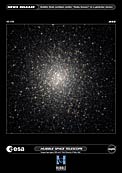Multiple generations of stars in a globular cluster
This NASA/ESA Hubble Space Telescope image of a dense swarm of stars shows the central region of the globular cluster NGC 2808.
Astronomers were surprised when Hubble spied three generations of cluster stars. The discovery is far different from the standard picture of a globular cluster. For decades, astronomers thought that cluster stars formed at the same time, in the same place, and from the same material, and have co-evolved for billions of years.
Globular clusters are among the earliest settlers of our Milky Way Galaxy, born during our galaxy's formation. They are compact swarms of typically hundreds of thousands of stars held together by gravity.
All the stars in NGC 2808 were born within 200 million years very early in the life of the 12.5-billion-year-old massive cluster. Of the about 150 known globular clusters in our Milky Way Galaxy, NGC 2808 is one of the most massive, containing more than 1 million stars.
The sharp resolution of Hubble's Advanced Camera for Surveys measured the brightness and colours of the cluster stars to find the three stellar populations.
The Hubble images were taken in May 2005 and in August and November 2006.
Credit:European Space Agency, NASA, G. Piotto (University of Padua, Italy) and A. Sarajedini (University of Florida, USA). Acknowledgement: Davide de Martin (ESA/Hubble)
About the Image
| Id: | heic0708a |
| Type: | Observation |
| Release date: | 2 May 2007, 15:00 |
| Related releases: | heic0708 |
| Size: | 3856 x 3864 px |
About the Object
| Name: | NGC 2808 |
| Type: | Milky Way : Star : Grouping : Cluster : Globular |
| Distance: | 30000 light years |
| Constellation: | Carina |
| Category: | Star Clusters |
Coordinates
| Position (RA): | 9 12 3.02 |
| Position (Dec): | -64° 51' 53.18" |
| Field of view: | 3.21 x 3.22 arcminutes |
| Orientation: | North is 25.5° right of vertical |
Colours & filters
| Band | Wavelength | Telescope |
|---|---|---|
| Optical B | 475 nm |
Hubble Space Telescope
ACS |
| Optical Pseudogreen (B+I) |
Hubble Space Telescope
ACS | |
| Infrared I | 814 nm |
Hubble Space Telescope
ACS |



